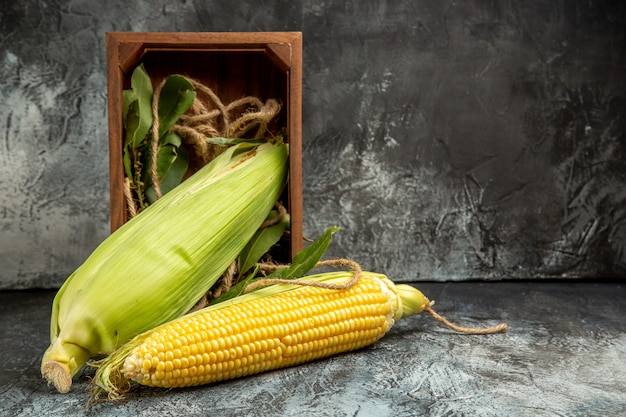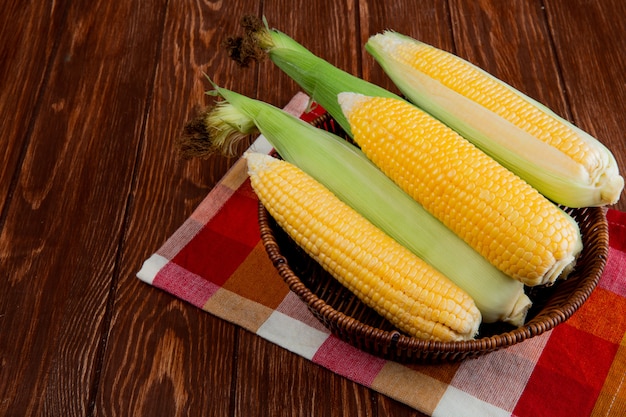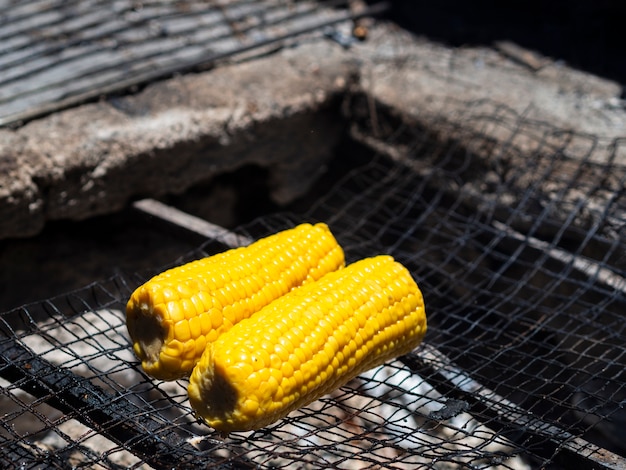Ah, summer. The air is warm, the sun is shining, and the smell of barbecue smoke hangs heavy in the air. It's the season for lazy afternoons spent in the garden, with a cold drink in hand and the sizzle of grilling in the background. And what better accompaniment to those quintessential summer moments than a perfectly grilled ear of corn?
But let's be honest, grilling corn on the cob isn't always a guaranteed success. Those sweet, juicy kernels can easily turn into burnt, dry disappointments if you're not careful. I've been there, friends. I've experienced the frustration of biting into a charred husk only to find the kernels raw and undercooked, a culinary tragedy that's hard to stomach.
But through years of trial and error, I've finally cracked the code. I've discovered the secrets to achieving the ultimate grilled corn on the cob experience, the kind that makes your tastebuds sing and leaves everyone asking for your recipe.
So, grab your tongs, gather your friends, and get ready to elevate your grilling game. Let's embark on a journey to perfect corn on the cob, one juicy, smoky kernel at a time.
(Part 1) Choosing the Perfect Corn

As with any culinary endeavor, the quality of your ingredients is paramount. And that means choosing the freshest, plumpest corn on the cob you can find. You want those kernels bursting with sweetness and flavour, ready to be transformed by the heat of the grill.
The Importance of Freshness
Freshness is key. You want corn that's been harvested recently, ideally within the past few days. Avoid corn that looks wilted, discolored, or has dried-out silk.
How to Check for Freshness
Here's a simple trick I learned from my granny, a woman who knew her way around a kitchen garden: Gently press your fingernail into a kernel. A fresh ear of corn will give a slight popping sound as the kernel yields under pressure. If it's soft and mushy, it's likely past its prime.
Seasonal Considerations
Corn is a seasonal delight, and the best time to enjoy it is during its peak season. In the UK, this typically runs from July to September, when the corn is at its sweetest and most flavourful.
(Part 2) Preparing the Corn

Shucking the Corn
Now that you've found your perfect corn, it's time to prepare it for the grill. This involves shucking the corn, which is the process of removing the husks and silks. Here's my preferred method:
- Start by peeling back the husks from the top of the ear, just enough to reveal the silk.
- Grab the silk at the top and pull it off in one swift motion. It should come off easily, leaving you with a clean ear of corn.
- You can leave the husks on at this point, or peel them back completely for a more traditional presentation.
The Husk Debate: On or Off?
Now comes the great corn on the cob debate: to husk or not to husk? This is a topic of heated discussion among grilling enthusiasts.
Those who advocate for leaving the husks on argue that they protect the kernels from direct heat, preventing them from scorching and helping to retain moisture. They believe it creates a natural "steaming" effect, resulting in tender, juicy kernels.
On the other hand, those who prefer to husk the corn completely argue that it allows for better browning and caramelization, resulting in a crispier texture and a more intense smoky flavour.
I fall somewhere in between. I like to leave the husks on for the initial grilling, but then peel them back halfway through to expose the kernels to the direct heat. This allows for the kernels to caramelize and develop a beautiful char while still retaining their moisture.
Adding Flavor to the Husks
No matter your preference on husking, you can add an extra layer of flavour by infusing the husks themselves. I love to rub the husks with a simple blend of garlic powder, smoked paprika, and a touch of cayenne pepper. It adds a smoky, spicy depth that complements the sweetness of the corn perfectly.
(Part 3) Grilling the Corn

The moment we've all been waiting for: grilling time! Get that grill nice and hot, ideally around medium-high heat. For a gas grill, aim for about 400°F. If you're using a charcoal grill, let the coals burn down to a bed of glowing embers.
Grilling Time
Place your prepared corn directly on the grill grates, ensuring even contact with the heat source. Turn the corn every 5-7 minutes to ensure even cooking and prevent those precious kernels from burning. You'll know it's done when the kernels are tender and the husks are slightly charred. This should take about 10-15 minutes in total.
The Importance of Regular Turning
Turning your corn regularly is essential. The kernels closest to the heat source will cook faster, so you need to rotate them to ensure every kernel is cooked to perfection. It's a bit like a dance, keeping those corn cobs moving and grooving on the grill.
(Part 4) Serving and Enhancing the Flavour
Now comes the fun part: serving your perfectly grilled corn on the cob. You can serve it hot off the grill, but personally, I prefer to let it cool slightly for a more relaxed experience.
Classic Serving Styles
There are countless ways to enjoy grilled corn on the cob, but here are a few of my favourites:
- Classic Butter and Salt: Sometimes the simplest things are the best. A generous pat of butter and a sprinkle of salt is all you need to enhance the natural sweetness of the corn.
- Herbed Butter: Elevate the classic with a mix of melted butter and your favourite herbs. Parsley, chives, and basil are excellent choices, adding a refreshing touch to the smoky flavour.
- Spice Rub: For a more adventurous palate, try a spice rub. Paprika, chili powder, cumin, and garlic powder are all excellent options, adding a depth of flavour and a touch of heat.
- Cheesy Delight: Sprinkle grated cheddar cheese over the warm corn for a cheesy indulgence.
- Spicy Mayo: Add a kick with a dollop of spicy mayonnaise.
Additional Tips
- To prevent the kernels from sticking to the grill grates, you can lightly brush them with a bit of oil before grilling.
- If you're concerned about the husks getting too charred, you can wrap the corn in foil for the first few minutes of grilling.
- Don't be afraid to season generously. A bit of salt and pepper can make a world of difference in bringing out the natural sweetness of the corn.
(Part 5) Beyond the Grill: Other Cooking Methods
While grilling is my go-to method for corn on the cob, there are other ways to achieve delicious results.
Roasting
For a more hands-off approach, consider roasting your corn. Preheat your oven to 400°F. Wrap each ear of corn in foil, ensuring a tight seal, then place them on a baking sheet and roast for about 30-40 minutes, or until tender. The foil helps to trap steam, resulting in juicy, flavourful corn.
Boiling
While not as glamorous as grilling or roasting, boiling is a simple and reliable method for cooking corn. Fill a large pot with water, add a tablespoon of salt, and bring it to a boil. Add the corn and simmer for 5-7 minutes, or until tender. The boiling water helps to cook the kernels evenly, resulting in a softer texture.
Microwave
In a pinch, you can cook corn in the microwave. Shuck the corn and place it on a microwave-safe plate. Microwave for 3-5 minutes, or until tender. This is a quick and easy option for a busy weeknight, but it won't achieve the same smoky flavour and caramelized texture as grilling or roasting.
(Part 6) corn on the cob variations
Grilled corn on the cob is a classic, but its versatility extends far beyond a simple side dish. Here are some ways to explore the delicious possibilities of grilled corn:
Grilled corn salad
Turn your grilled corn into a vibrant salad. Simply cut the kernels off the cob, combine them with your favourite fresh vegetables (like tomatoes, cucumbers, and bell peppers), and toss with a tangy vinaigrette or a creamy dressing. It's a light and refreshing summer salad that's perfect for picnics or potlucks.
Corn Fritters
For a more substantial treat, try corn fritters. Grate the kernels from grilled corn, combine them with flour, eggs, spices, and a touch of cheese (optional), then fry them until golden brown and crispy. Serve them with a dollop of sour cream or a spicy dipping sauce for a flavour explosion.
Corn Chowder
Grilled corn adds a smoky depth to creamy chowder. Puree the cooked corn with potatoes, onions, and milk, then season with herbs and spices. You can also add bacon, sausage, or seafood for a more substantial meal.
(Part 7) Corn on the Cob: A culinary journey Through the Ages
Corn, or maize, has a rich and fascinating history that spans millennia. It originated in Mesoamerica and was a staple food for ancient civilizations like the Mayans and Aztecs.
Ancient Origins
Archaeological evidence suggests that corn was domesticated in Mexico around 9,000 years ago. The Aztecs revered corn as a sacred grain, believing it was a gift from the gods. It played a central role in their culture, religion, and everyday life.
Spread Across the Globe
Corn eventually spread to other parts of the world, thanks to the voyages of Christopher Columbus and other explorers. It reached Europe in the 15th century and quickly became a popular crop due to its versatility and nutritional value. It was readily adopted by farmers in various countries, and it soon became a staple food in many cultures around the world.
The Evolution of Cooking Methods
The ways we cook corn have evolved over the centuries. From ancient methods like roasting over an open fire, to modern techniques like grilling, roasting, and even microwaving, corn has remained a culinary favourite.
(Part 8) Nutritional Benefits of Corn
Beyond its deliciousness, corn offers a wealth of nutritional benefits. It's a good source of fibre, vitamins, and minerals, making it a valuable addition to a balanced diet.
A Source of Essential Nutrients
Corn is particularly rich in vitamin A, which is essential for good vision, healthy skin, and immune function. It's also a good source of vitamin C, an antioxidant that helps protect against cell damage. Corn contains important minerals like potassium, which is crucial for maintaining blood pressure and muscle function.
Health Benefits
Regular consumption of corn can contribute to overall health and well-being. Its fibre content can aid digestion, and it's a good source of complex carbohydrates, providing sustained energy levels. Corn also contains antioxidants that may help protect against chronic diseases.
Versatile and Delicious
Whether you're enjoying it as a side dish, incorporating it into salads and soups, or using it as an ingredient in baked goods and desserts, corn is a truly versatile and delicious food that can be enjoyed in countless ways.
(Part 9) Corn on the Cob: A Personal Reflection
For me, corn on the cob evokes warm childhood memories. I remember spending summer afternoons in my grandfather's garden, helping him pick fresh ears of corn. The sweet, juicy kernels, the scent of freshly cut corn stalks, and the warmth of the summer sun – these are memories I cherish.
Grilling corn is more than just a cooking method; it's a tradition, a connection to the past, and a celebration of simple pleasures. It's a reminder that good food, good company, and a warm summer night are all you need for a perfect evening.
FAQs
Q: What is the best way to store corn on the cob?
A: Store unshucked corn in the refrigerator for up to a week. The husks will help to keep the kernels moist and prevent them from drying out. If you need to store it longer, you can freeze it.
Q: Can I freeze corn on the cob?
A: Yes, you can freeze corn on the cob. Simply shuck the corn and blanch it in boiling water for 3-5 minutes. Then, cool the corn in an ice bath, drain it, and wrap it tightly in plastic wrap or aluminum foil. Place the wrapped corn in a freezer bag and freeze for up to 6 months.
Q: What are some good substitutes for butter on corn on the cob?
A: If you're looking for a healthier alternative to butter, you can use olive oil, coconut oil, or avocado oil. You can also try a vegan butter substitute, or even a simple squeeze of lemon juice.
Q: How do I know if my corn on the cob is cooked?
A: A cooked corn on the cob will have tender kernels that easily pull away from the cob. The husks will also be slightly charred and will have a smoky aroma.
Q: Can I grill corn on the cob on a gas grill?
A: Absolutely! You can grill corn on the cob on a gas grill, just make sure the heat is set to medium-high.
Everyone is watching

Corn on the Cob: The Ultimate Guide to Perfectly Cooked Ears
Healthy MealsAh, corn on the cob. Just the name evokes images of sunny days, barbecues, and that sweet, juicy flavour that ...

Perfect Pork Roast Oven Cooking Time: A Guide to Delicious Results
Healthy MealsThere's something truly satisfying about a perfectly roasted pork. The aroma alone is enough to make your mout...

Scallops: The Ultimate Guide to Perfect Cooking
Healthy MealsAh, scallops. Those delicate, sweet, and utterly delicious morsels of the sea. They hold a special place in my...

Spaghetti Squash: The Ultimate Guide to Cooking and Serving
Healthy MealsRemember that time you saw spaghetti squash at the supermarket, looking all bumpy and strange, and thought, "W...

Ham Cooking Time: How Long to Bake, Smoke, or Boil a Delicious Ham
Healthy MealsAh, ham. It's a classic, isn't it? A real crowd-pleaser, especially around holidays. And when done right, it'...
